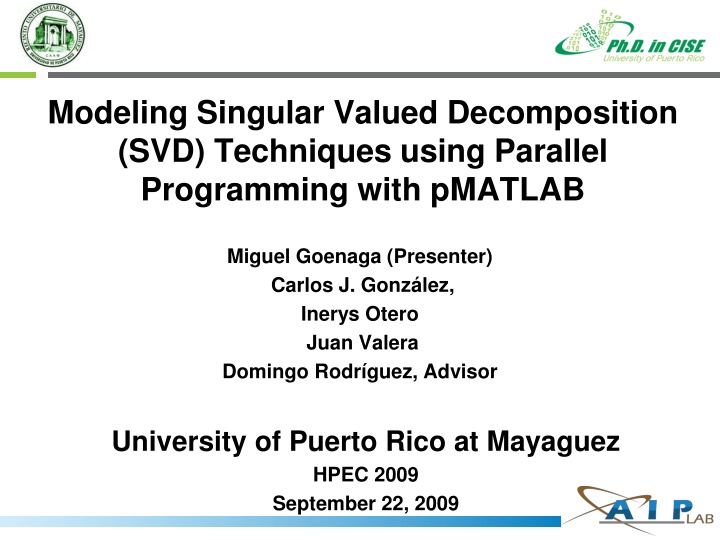
Modeling Singular Valued Decomposition (SVD) Techniques with pMATLAB
Learn about parallel programming techniques using pMATLAB for modeling Singular Valued Decomposition (SVD) in circulant matrices with circulant blocks. Explore the implementation and performance results of this approach for filtering operations in hyperspectral images.
Download Presentation

Please find below an Image/Link to download the presentation.
The content on the website is provided AS IS for your information and personal use only. It may not be sold, licensed, or shared on other websites without obtaining consent from the author. If you encounter any issues during the download, it is possible that the publisher has removed the file from their server.
You are allowed to download the files provided on this website for personal or commercial use, subject to the condition that they are used lawfully. All files are the property of their respective owners.
The content on the website is provided AS IS for your information and personal use only. It may not be sold, licensed, or shared on other websites without obtaining consent from the author.
E N D
Presentation Transcript
Modeling Singular Valued Decomposition (SVD) Techniques using Parallel Programming with pMATLAB Miguel Goenaga (Presenter) Carlos J. Gonz lez, Inerys Otero Juan Valera Domingo Rodr guez, Advisor University of Puerto Rico at Mayaguez HPEC 2009 September 22, 2009
Problem Formulation This work seeks the decomposition of a circulant matrix with circulant blocks using pMATLAB for filtering operations on hyperspectral images. Previous Work Singular value decomposition transform with and FFT-based algorithm on the Connection Machine CM5 [1]. Kronecker products and SVD approximations in image restoration [2]. Effective algorithms with circulant-block matrices [3]. Solution Approach Given a circulant block matrix A, it is desirable to solve for the following proposition [1]: The SVD of an N2-by-N2 circulant block matrix A is formulated according to [1]: HPEC 2009
Implementation Results Mathematical Model Approach A Kronecker product commutation property from [4] was used to arrive at the model: The following transformation was obtained: The modeling formulation for SVD computation is presented as follows : Computational Parallel Pseudo-Algorithm HPEC 2009
Performance Results pMATLAB Contributions: Parallelized calculation of the circulant matrix with circulant blocks. Parallelized matrix multiplications and the use of Kronecker products. Execution Time 3 10 Execution Time [seconds] 2 10 1 10 References: [1] Cao-Huu, T. and Evequoz, C. Singular value decomposition transform with and FFT-based algorithm on the Connection Machine CM5, Electrical and Computer Engineering Canadian Conference, CCECE, vol. 2,pp.1046-1049, Sept. 5-8, 1995. 0 10 -1 SVD via FFT Kronecker Serial SVD via FFT Kronecker Parallel Np=2 SVD via FFT Kronecker Parallel Np=4 10 2000 4000 Circular Matrix Dimension (NxN) [# of points] 6000 8000 10000 12000 14000 16000 [2] Kamm, J. and Nagy, J. Kronecker product and SVD approximations in the image restoration , Linear Algebra and its Applications, vol. 284, iss. 1-3, pp. 177- 192, November 15, 1998. Figure 1: Execution time comparison between SVDs using a serial algorithm and the pMATLAB environment with Np=2 and Np=4. [3] Rjasanow, S. Effective Algorithms With Circulant-Block Matrices, Linear algebra and its applications, vol. 202, pp. 55-69, 1994. [4] Van Loan, C. F. The ubiquitous Kronecker product, Journal of Computational and Applied Mathematics, vol. 123, iss. 1-2, pp. 85-100, November 2000. HPEC 2009






















